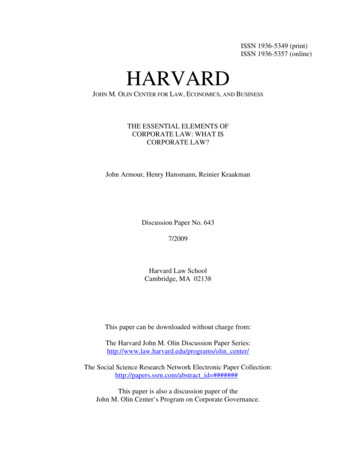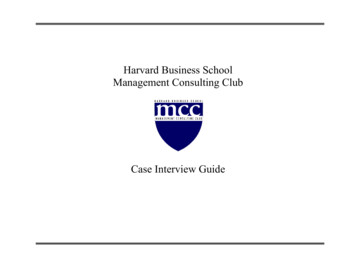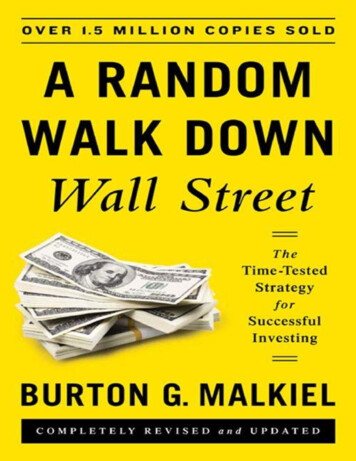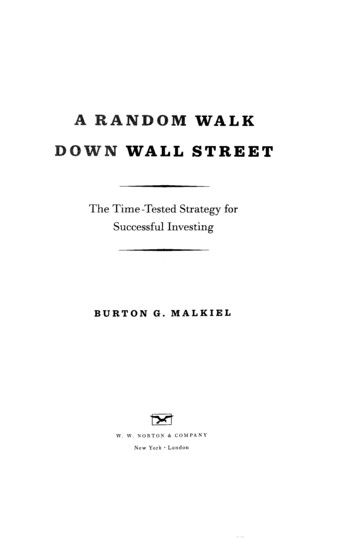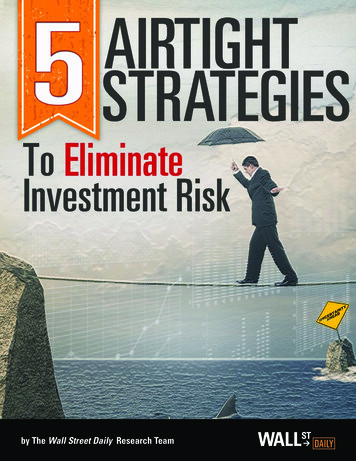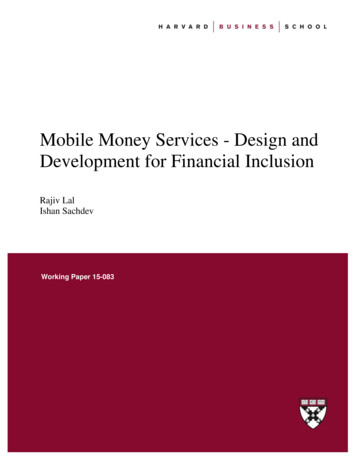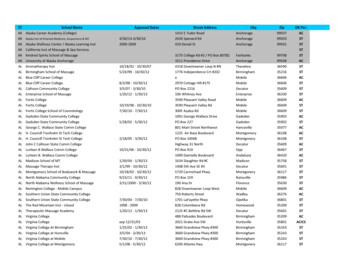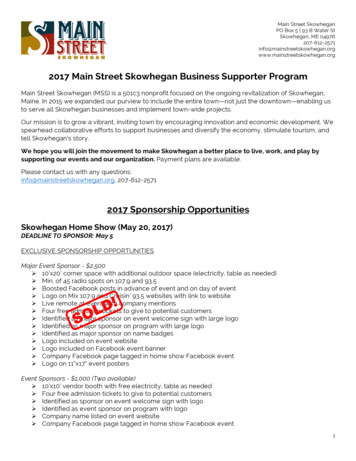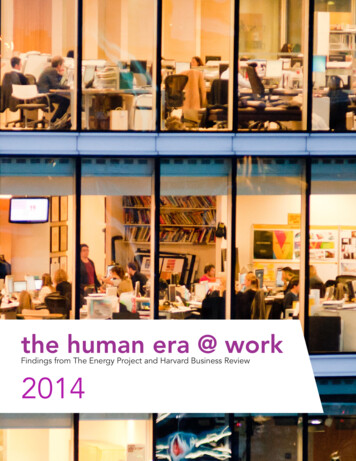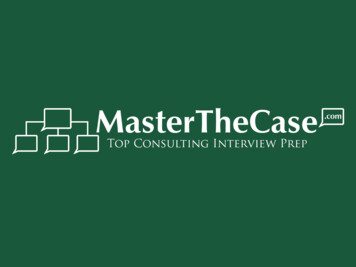
Transcription
Harvard Business SchoolManagement Consulting ClubCase Interview Guide2011Cases contributed by Management Consulting Club and consulting companies.Note: Case guide is strictly for the use of current HBS Management Consulting Club members. No part of thisdocument may be reproduced or transmitted in any form or by any means—electronic, mechanical, photocopying,recording, or otherwise—without the written permission of HBS Management Consulting Club.
Company Provided Case – Telecom Co. (pg. 1 of 11)Bain & Co.Case summary for facilitator onlyIndustryTelecomPrimary issueMarket entryOther topicsInvestment business case, break even analysisSituationClient provides satellite TV services (DBS) nationallyComplicationCustomer base being threatened by telcos and cable companies (triple play)Consider deploying wireless network (WiMAX) to offer broadband internetKey questionsShould the client go into the WiMAX business?Key componentsSuggested framework: quantify revenues and costs; analyze risksQuantitative: analyze costs and revenue of new ventureAnswerThe investment is too high and would take years to break even; client should focus on defending core business(satellite TV)21
Company Provided Case – Telecom Co. (pg. 2 of 11)Bain & Co.Case summary for facilitator onlyAdditional Background Our client is a provider of satellite TV services Client facing increased pressure on its customer base from telcos andcable companies offering “triple play” bundles of TV, internet, andphone services Client considering deploying WiMAX wireless networks across the USAto offer its customers broadband internet (and potentially phoneservice - VoIP)- Offering triple play will allow the client to compete with telcosand cable companies Deploying WiMAX is extremely expensive, driven by:- Spectrum costs: acquiring frequencies from the federalgovernment- Base stations,: tower that send/receive wireless signal (similar tocellular)- CPE: customer premise equipment- Additional SG&A Revenue upside consists of 6M subscribers in the USA (based on mgm’testimates of 5% market share) paying 20/mo Total investment 2.6B; potential revenue upside: 2.44B; since mostcosts are variable (per customer) could not break even in year 1 Client should focus on defending its core market of satellite TVMarket share (mgm’testimate)Base stationbandwidthBandwidth requireper household% of concurrentconnections*Broadband internetservice price5%80,000 kbps320 kbps50 % 20 per mo* Telecom companies balance the cost per subscriber andrequired bandwidth per sub by estimating the % of subswho are online at any point in time22
Company Provided Case – Telecom Co. (pg. 3 of 11)Bain & Co.Question Our client provides satellite TV service nationwide. The customer base is being threatened by telcos and cablecompanies offering “triple play,” so our client is considering deploying wireless network (WiMAX) to offerbroadband internet. Should our client go into the broadband business?23
Company Provided Case – Telecom Co. (pg. 4 of 11)Bain & Co.Recommended SolutionFrame the ProblemCosts: Capital expenditures- Base stations (towers)- Getting the licenses- Additional equipment Operational excellence/ongoing costs- Maintenance- Leases etc. SG&A- Additional sales and marketing effortsPotential Revenues: Market share- How big is the market?- What is a reasonable market shareassumption? Pricing- Market price for broadband services?- How price sensitive are consumers?Key issues/challenges: Buy vs. build? Competitive moves? Regulatory issues?Total costNetwork costSpectrum How muchwould thespectrum(license) be?- What canhistoricdata tellus?Base StationsSG&ACustomer PremiseEquipment* Should we buy or What is the cost oflease basethe equipment thatstations?is required on thecustomer’s-# of towers arepremises?required?-Capex What % of the costassociated with could be passed onbuilding/leasinto the customer?g basestations?-What are theoperational(ongoing)expenses? Do we have toinvest in marketingand sales?Assumethese costsare minimalinitially andfocus onnetworkcosts24
Company Provided Case – Telecom Co. (pg. 5 of 11)Bain & Co.Recommended SolutionDig deeperSpectrum auction price 80NovVerizon500MCosts: SpectrumAssume spectrum price average of 500M25
Company Provided Case – Telecom Co. (pg. 6 of 11)Bain & Co.Recommended SolutionDig deeperCosts: Base stationsBase station cost # of base stations * Cost per base stationDetermine # of base stationsUS population ( 300M) Base station bandwidth(80,000 kbps)xPersons per household (2.5) Bandwitch per household(320 kbps)# of households (120M)xx% of concurrentconnections* (50%)Market share (5%) # of serviceable households(120M) Households per base station(500) # of base stations(12,000)* Telecom companies balance the cost per subscriber and required bandwidth per sub by estimating the % of subs who are online at any point in time26
Company Provided Case – Telecom Co. (pg. 7 of 11)Bain & Co.Recommended SolutionDig deeperCosts: Base stationsBase station cost # of base stations * Cost per base stationDetermine cost per base stationQualitativeQuantiativeBuild (Own & Operate)DescriptionAdvantagesLease Completely plan, construct, Lease towers andand operate a proprietarybandwidth for a rental andnetwork of towersmaintenance fee Complete control overnetwork footprint Smaller up-frontinvestment Best tower real estate canbe used for network- Higher location ontower preferable Time-to-market advantageas towers already existBuildSingle base station 400K300operate Longer time-to-market Availability of towers- Coverage notpossible if tower realestate unavailable ingiven location380Single base station150 c.ElectronicsPlanning &Design100Backhaullease200100Disadvantages Very costly to own &LeaseElectronics50Tower lease0CAPEX & OPEX0OPEXLeasing will require lower initial investment andallow faster time to market27
Company Provided Case – Telecom Co. (pg. 8 of 11)Bain & Co.Recommended SolutionDig deeperCosts: Base stationsBase station cost # of base stations * Cost per base station# of base stations(12,000)xCost per base station( 150k) Total base station cost( 1.8B)* Telecom companies balance the cost per subscriber and required bandwidth per sub by estimating the % of subs who are online at any point in time28
Company Provided Case – Telecom Co. (pg. 9 of 11)Bain & Co.Recommended SolutionDig deeperCosts: Customer premise equipmentAdditional Information upon askingCPE cost is 150 per householdClient estimates 2/3 of costs could be passed through to customerCPE Net cost to the client 300M29
Company Provided Case – Telecom Co. (pg. 10 of 11)Bain & Co.Recommended SolutionDig deeperIncremental Revenue vs. CostsRevenuesBroadbandinternet onlyInternet andvoice (phone)CostsTriple play(defending core)Total cost To be conservative, assume internet only Assume price is 20 per monthNetwork costSG&AAssumed minimal6M subscribers x 20/mo x 12mo 1,440MTotal revenue: 1.4BSpectrumBase StationsCustomer PremiseEquipment* 500M 1,800M 300MTotal cost: 2.6B30
Company Provided Case – Telecom Co. (pg. 11 of 11)Bain & Co.Recommended SolutionKey Findings Deploying a WiMAX network solution across the USA is extremely expensive; even with leasing base stations,the network cost amounts to 2.6B Revenue uplift from broadband service would total 1.44B and would not enable the client to break even inyear 1 Additional costs may be incurred Some risks concerning timing of deploying and market pricing need to be addressedRecommendation Investment in a WiMAX solution probably does not make sense due to high up-front costs andlower revenue uplift The client should focus on defending the core business of satellite TV; client should consider thefollowing:- Segment customers and increase share with most profitable segments- Grow scale to reduce cost per subscriber- Go into content: look for acquisition/ partnership to drive differentiated content- Technology innovation: Offer DVR to compete with cables’ VOD Increase number of local and national HD channels- Partner for broadband. E.g., partner with telcos where they are not building video infrastructure31
Company Provided Case – Brand Builders Inc. (pg. 1 of 11)Bain & Co.Case summary for facilitator onlyIndustryConsumer Products/ RetailPrimary issuePortfolio managementOther topicsCost benchmarks, profit marginsSituationApparel manufacturer, Brand Builders Inc., owns a portfolio of apparel brandsHistoric growth has been in line with marketComplicationManagement wants to invest to drive growthKey questionsHow should management select brands for investment?Key componentsSuggested framework: size, growth, profitability, strategic fitQuantitative: internal benchmarks, calculate cost savingsAnswerManagement should prioritize the five largest, fastest growing brands for investment. There is an opportunity toreduce costs on Brand E, which is currently unprofitable32
Company Provided Case – Brand Builders Inc. (pg. 2 of 11)Bain & Co.Case summary for facilitator onlyAdditional Background An apparel manufacturer, Brand Builders Inc., owns a portfolio of fifteen brands Historic growth has been in line with the market, and portfolio profitability is sound Management wants to invest to grow the portfolio but is unsure about how to prioritize their investment The brands are categorized in two segments: Classic and Contemporary- Classic is slow-growing: projected 5-yr CAGR 1%- Contemporary is fast-growing: projected 5-yr CAGR 4% The brands are of varying sizes and growth rates- Brands E and H are the largest Classic brands, and have growth rates in line with or ahead of the market- Brands B, K, and M are the largest Contemporary brands, and have lagged the market Four of the top 5 brands are profitable: H, B, K, and M- Brand E is not profitable Brand Builders should also consider brands in its portfolio for strategic investment: access to customers, channels,or organizational learning Brand E is not profitable- Internal benchmarking shows E overspending, driven by Design and Supply Chain- Reducing costs in Brand E would lead to 6M savings, and a 20% profit margin Brand Builders should invest in its largest brands, and should reduce costs in Brand E to drive profitability33
Company Provided Case – Brand Builders Inc. (pg. 3 of 11)Bain & Co.Question Apparel manufacturer, Brand Builders Inc., owns a portfolio of apparel brands. Historic growth has been in line withmarket. Management wants to invest to drive growth. How should management select brands for investment?Recommended SolutionFrame the ProblemApproach: Consider the size and growth of the brands Screen the largest, fastest growing brands forprofitability Review the smaller brands for strategicinvestmentBrand sizeBrand growthpotentialBrand profitability34
Company Provided Case – Brand Builders Inc. (pg. 4 of 11)Bain & Co.Available DataRevenue by brandClassicRevenue by brandContemporary30 30M2725201816131013107730Brand A11BCD3EF2GHI1JKLMNO5 yr CAGR 1% 1% 4% 2% 1% 5% 3% 5% 2% 4% 3% 2% 1% 5% 3%35
Company Provided Case – Brand Builders Inc. (pg. 5 of 11)Bain & Co.Available DataMarket growth rates5 year %Projected0.0ClassicContemporary36
Company Provided Case – Brand Builders Inc. (pg. 6 of 11)Bain & Co.Recommended SolutionDig DeeperForm a hypothesis about what you will recommend based on the initial dataBrand sizeHypothesis: Brand sizes varysignificantly, evenwithin segmentsBrand growth potentialBrand profitability The brands havehistorically grown atdifferent growth rates Brands B, E, H, K, andM are the largest,fastest growing brands The Contemporarysegment is projectedto grow more quicklythan Classic Need to understandthe profitability of thevarious brands37
Company Provided Case – Brand Builders Inc. (pg. 7 of 11)Bain & Co.Available DataFinancials for selected brandsBEHKM 16 M 25 M 30 M 18 M 27 M69116101016191217Design36534Supply 28%15%Gross salesCOGSNet salesProfit margin38
Company Provided Case – Brand Builders Inc. (pg. 8 of 11)Bain & Co.Recommended SolutionKey Findings In the Brand Builders portfolio, we selected the top 5 brands by revenue: B, E, H, K, M The top 5 brands are growing at different rates, varying from 1-5% The brands are in two main segments, Classic and Contemporary- Classic is expected to grow more slowly than Contemporary (1% vs 4%) Segment growth does not appear to be a good predictor of brand growth Four of the top 5 brands are profitable- Brand E is not profitableDig Deeper Brand E is the only unprofitable brand Need to understand if Brand E can be turned around Benchmarking against the other brands will reveal source of losses[Need to benchmark cost against a temporary and a classic brand]39
Company Provided Case – Brand Builders Inc. (pg. 9 of 11)Bain & Co.Recommended SolutionDig DeeperWhy is Brand E unprofitable?[Candidate should calculate financials as a percent of net sales to compare across brands]B ME% netsales MH% netsales M% netsalesGross sales162530Net sales101619Design330%6 40%5 25%Supply chain220%5 30%4 20%Sales220%3 20%3 15%G&A110%3 20%3 15%Profit2(1)413%-4%13%Profit margin40
Company Provided Case – Brand Builders Inc. (pg. 10 of 11)Bain & Co.Recommended SolutionDig DeeperNeed to calculate impact of achieving internal benchmarksB% netsalesE MGross sales25Net sales16HSavings potential for E% netsales% netsalesCalculation MDesign30%6 40% 25%6M–(25% of 16) 2MSupply chain20%5 30% 20%5M–(20% of 16) 2MSales20%3 20% 15%3M–(15% of 16) .5MG&A10%3 20% 15%3M-(10% of 16) 1.5MProfitPr
Note: Case guide is strictly for the use of current HBS Management Consulting Club members. No part of this document may be reproduced or transmitted in any form or by any means—electronic, mechanical, photocopying, recording, or otherwise—without the written permission of HBS
